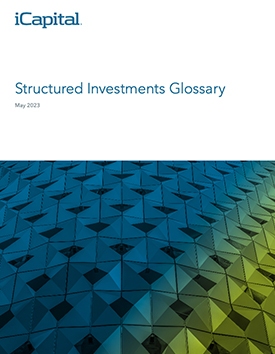A
Absolute Return – A type of payment offered on some Structured Investments, where the payment that investors receive at maturity is equal to the absolute value of the Underlier’s return, generally up to a specified level.
Accrual Coupon – A type of Coupon payment offered on some Income Products. The Coupon is based on the number of days that the Underlier satisfies a specified Contingency(ies), often that the Underlier is at or above a specified level, in which case the more days the Underlier is at or above the specified level, the higher the Coupon payment.
Autocall Premium – A type of payment made on some Autocallable Structured Investments. An Autocall Premium is a predetermined payment amount, as calculated and described in the Prospectus or offering document, that is paid to investors if the product is automatically redeemed (“autocalled”) prior to the scheduled Maturity Date.
Autocallable – A type of Callable product, which will automatically be redeemed (“autocalled”) prior to the scheduled Maturity Date if the Underlier satisfies a specified Contingency(ies), often that the Underlier is at or above a specified level on a predetermined date or dates. If autocalled, the investor receives Principal invested plus any potential Coupon or Autocall Premium earned on the given Observation Date.
B
Barrier – A type of Buffer that absorbs a fixed percentage of the Underlier’s decline; however, if the Underlier declines beyond a specified level, the protection disappears and losses are one-for-one from the Underlier’s Initial Level. Barriers may be observed continuously, daily, or at maturity. Barriers are generally considered the riskiest type of Buffer associated with Structured Investments.
Bearish – An investment view characterized by falling share prices.
Buffer – A form of protection of an investor’s Principal. The Buffer absorbs a fixed percentage of the Underlier’s decline, after which the investor participates in the decline in the Underlier. Hard Buffers, Geared Buffers, Deleveraged Buffers, and Barriers are all different types of Buffers.
C
Call Observation Date – The date or dates on which a Structured Investment may be redeemed prior to maturity and an investor’s Principal returned. On each Call Observation Date, Structured Investments can either be called at the Issuer’s discretion or autocalled if the Underlier satisfies a specified Contingency(ies), depending on the terms of the Structured Investment.
Callable – The ability for a Structured Investment to be redeemed prior to maturity. Structured Investments can be callable at the Issuer’s discretion or autocalled if the Underlier satisfies a specified Contingency(ies) on a predetermined date or dates, depending on the terms of the Structured Investment.
Contingency – A condition that must be met in order for an event to happen or a payment to be paid.
Contingent Coupon – A type of Coupon offered on some Income Products. The investor receives a Coupon if a specified Contingency(ies) is satisfied, typically that the Underlier is at or above a specified level on a predetermined date or dates.
Coupon – A periodic payment received by the investor over the life of an investment, or paid at maturity, subject to the terms described in the Prospectus or offering document of the Structured Investment.
Coupon Contingency – The specified level that the Underlier must be at or above on a predetermined date or dates in order for investor to accrue or receive a Coupon. A Coupon Contingency is associated with Income Products with Contingent Coupons and Accrual Coupons.
Credit Risk – The risk that the Issuer will default and not meet its principal and interest obligations. This factor must be considered when evaluating Structured Investments relative to traditional equity investments. Credit Risk can also be known as default risk.
Current Note or CD Value – The price of a Note or CD, as provided by the Issuer, or an affiliated or unaffiliated broker-dealer, quoted as a percentage of the face amount, reflecting the performance of the Underlier and current market conditions that may impact the price of the Note or CD.
Cusip – A unique product identifier that is assigned to each Structured Investment and other securities.
D
Deleveraged Buffer – A type of Buffer that absorbs a certain percentage of losses in the Underlier. Investors take losses at a rate that is less than one-to-one with losses in the Underlier.
Determination Date – The date on which the Final Level of the Underlier is determined and the Settlement Amount of the investment is calculated.
Digital Payment – A type of payment offered on some Structured Investments, where the payment that investors receive at maturity is contingent upon the Underlier being at or above a specified level at maturity.
E
Estimated Initial Value – A calculated level provided by the Issuer that approximates the value of your Structured Investment on Trade Date. The Estimated Initial Value on Trade Date may not reflect the value that appears on a investor’s statement, but is typically disclosed in the final Prospectus or offering document. This term may also be referred to as Estimated Value.
Expiration – The final possible event observed for a given Structured Investment.
F
FDIC Insured – Market Linked Certificates of Deposit (“CDs”) are insured by the Federal Deposit Insurance Corporation, or FDIC, a US Government Agency that provides deposit insurance backed by the full faith and credit of the United States Government up to $250,000. Market Linked Notes are not FDIC insured.
Final Level – The value of the Underlier, set on the Determination Date, against which the Initial Level is measured to determine the payout of the Structured Investment.
Fixed Coupon – A type of Coupon offered on some Income Products. The investor receives a fixed payment on a periodic basis throughout the life of the trade, regardless of the performance of the Underlier.
Fixed Term – A type of Structured Investment that is not Callable. It will remain outstanding until the scheduled Maturity Date and investors will remain invested for the full term as stated in the Prospectus or offering document.
Floor – A type of downside protection of an investor’s Principal, where the investor takes losses that are one-to-one with the market for a fixed percentage of losses in the Underlier. After the fixed percentage, the Floor absorbs additional losses. A Floor provides a maximum fixed percentage of potential loss exposure to the Underlier.
G
Geared Buffer – A type of Buffer that absorbs a fixed percentage of the Underlier’s decline, after which point losses are leveraged to the market (i.e. losses are more than one-to-one with the return of the market beyond the buffer). Geared Buffers are considered riskier than Hard Buffers with the same buffer amount, because the investor may lose full Principal in the event of a steep market downturn at maturity.
Growth Product – An investment designed for an investor looking to grow his/her assets, generally characterized by a single payment at maturity.
H
Hard Buffer – A type of Buffer that absorbs a fixed percentage of the Underlier’s loss and, after that, losses are one-to-one with the market. Hard Buffers are generally considered more conservative than Geared Buffers and Barriers.
I
Income Product – An investment designed for an investor looking to earn income/yield on his/her assets, generally characterized by the potential to earn Coupon payments during the life of the investment.
Initial Level – The value of the Underlier, set on the Trade Date, against which the Final Level is measured to determine the payout of the Structured Investment.
Intrinsic Value – A calculation of what the payment would be on a Structured Investment if the Underlier was at its Current Level on Maturity Date. Intrinsic Value differs from Current Note or CD Value, given Current Note or CD Value takes into account a number of factors related to the remaining holding period of the Note or CD, including, but not limited to, time to maturity, interest rates, credit spreads, and implied volatility.
Investment Horizon – The time period over which an investor expects his/her investment views may be realized.
Issuer – A legal entity responsible for the issuance of the Structured Investment, and to which holders of the Structured Investment are exposed to Credit Risk.
Issuer Callable – A type of Callable product, where, on any Call Observation Date, the Issuer may choose, in its discretion, to redeem the investment prior to scheduled Maturity Date. If called by the Issuer, the investor receives Principal invested plus any Coupon earned on the given Observation Date.
Issuer Protected – A feature of Structured Investments where the principal amount will be returned at maturity, subject to the Credit Risk of the Issuer. Investors must be comfortable with the creditworthiness of the Issuer and must hold the note until maturity in order to receive full principal back.
L
Leverage – A feature in some Structured Investments where the upside potential is more than one-to-one with the return of the Underlier.
M
Market Linked CD – A type of Structured Investment where the Principal amount is insured by the FDIC, up to applicable limits, in the event of Issuer default. Market Linked CDs have the potential to earn more than traditional, fixed rate Certificates of Deposit because their returns are linked to the performance of an Underlier (e.g. S&P 500), however the investor also foregoes potential interest received from a traditional CD to participate in the potential long-term growth and income.
Market Linked Note – A type of Structured Investment where the Principal Amount is invested in a debt obligation of the Issuer, with returns linked to the performance of an Underlier (e.g. S&P 500). Like traditional corporate bonds, Market Linked Notes carry the Credit Risk of the Issuer.
Maturity Date – Maturity Date refers to the date at which the Structured Investment will be redeemed, subject to the possibility of it being called or automatically redeemed prior to such date.
Max Return – The highest possible settlement amount, as a percentage of the Notional Amount invested, that the investor could receive on the Maturity Date.
Minimum Coupon – A type of Coupon offered on some Income Products. The investor receives a minimum fixed payment on a periodic basis throughout the life of the trade.
N
Non-Call Period – The period following Trade Date during which Callable Structured Investments are not eligible to be called for redemption.
Notional Amount – The nominal or face amount that the investor originally purchased on Trade Date and used to calculate payments made on that investment. This term may also be referred to as Principal Amount.
O
Observation Date – A date on which the level of the Underlier is measured in order to calculate payments made on the investment for a given event.
P
Payment Date – The date on which payment is due for a given event.
Performance Coupon – A type of Coupon offered on some Income Products. The Coupon amount an investor receives is determined using the performance of the Underlier or a basket of Underliers, as calculated and described in the Prospectus or offering document.
Principal Amount / Principal – The nominal or face amount that is originally invested on Trade Date and used to calculate payments made on that investment. Principal Amount can also be known as the Notional Amount.
Prospectus – The formal legal document, generally filed with the SEC, that provides details about the Structured Investment, including material information relating to the Issuer and the terms and risks of the investment.
Proximity to Coupon Contingency – The difference between the Underlier’s Current Level and the Coupon Contingency Level. The Coupon Contingency must be met in order for a coupon to be paid on the Structured Investment. Generally, if the Underlier’s Current Level is at or above the Coupon Contingency Level on a given Observation Date, a coupon would be paid on the Structured Investment with respect to such Observation Date.
Proximity to Current Call Level – The difference between the Underlier’s Current Level and the Call Contingency Level. The Call Contingency must be met in order for the Structured Investment to be automatically redeemed. Generally, if the Underlier’s Current Level is at or above the Current Call Level on a given Observation Date, the investment would be automatically called on such Observation Date.
Proximity to Digital Contingency – The difference between the Underlier’s Current Level and the Digital Contingency Level. The Digital Contingency must be met in order for the investor to receive the Digital Payment at maturity. Generally, if the Underlier’s Current Level is at or above the Digital Contingency Level at maturity, the investor will receive a Digital Payment.
Proximity to Protection Level – The difference between the Underlier’s Current Level and the level at which protection is no longer provided. Generally, if the Underlier’s Current Level is below the Protection Level on a given Observation Date, the holder of the Note or CD would be exposed to losses on such Observation Date.
R
Risk Tolerance – The degree of Volatility in investment returns that an individual is willing to withstand. An individual should have a realistic understanding of his or her ability and willingness to bear large swings and losses in the value of his or her investments.
S
Sales Concession – The percentage of the Notional Amount invested that will be paid as a commission on the sale of the Structured Investment. Sales Concessions are published in the Prospectus or offering document and publicly available for investors to view.
Secondary Market – The venue in which an investor may be able to sell a Structured Investment prior to the Maturity Date. Structured Investments are buy and hold investments, which means that they are meant to be held to maturity and there is no guaranteed Secondary Market. Historically, Issuers have generally bought back Structured Investments; however, Issuers are under no legal obligation to do so.
Settlement Amount – The amount of money, expressed as dollars of the Notional Amount invested, that the investor receives for a Structured Investment if held to the Maturity Date. This amount is calculated on the Determination Date and paid to the investor on the Maturity Date.
Settlement Date – The date by which the investor must pay for the Structured Investment in exchange for delivery by the Issuer.
Structured Investment – A type of investment, where returns are linked to the performance of a reference asset, or the Underlier, which is typically an index, ETF, or stock.
T
Tenor – A finite time period at the end of which the Structured Investment will be redeemed, subject to the possibility of it being called prior to Maturity Date. Only Callable or Autocallable Structured Investments can be called prior to Maturity Date. This term may also be referred to as maturity.
Total Coupons Earned – Cumulative coupons that have been earned since Trade Date.
Trade Date – The date that the investor’s obligation to pay and Issuer’s obligation to deliver arises. Typically, a Structured Investment is priced on this date and the Initial Level is determined.
U
Uncapped – When a Structured Investment has no defined Max Return. Uncapped investments allow investors to participate in positive price returns of the Underlier(s).
Underlier – All Structured Investments provide a return that are based on or linked to the performance of a reference asset, or the Underlier, which is typically an index, ETF, or stock.
Underlier Return – The difference between the Underlier’s Current Level and Initial Level, divided by the Underlier’s Initial Level.
Unprotected – A type of Structured Investment that does not offer any type of protection of an investor’s Principal against a market downturn.
Upside Participation – A type of payment offered on some Structured Investments, where the payment that investors receive at maturity will be based on the performance of the Underlier. Upside Participation will sometimes include Leverage and may be subject to a Max Return, but will not include any dividend payments made by the Underlier.
V
Volatility – A statistical measure of the dispersion of returns. Historical volatility is derived from time series of past market prices while implied volatility is forward-looking. Volatility may be viewed as one proxy for measuring risk, in that higher volatility assets are often perceived as riskier investments than assets with lower volatility.
Securities products and services may be offered through iCapital Markets, LLC a registered broker/dealer, member FINRA and SIPC, and an affiliate of Institutional Capital Network, Inc. (“iCapital”). Please see the disclaimer at the end of this document for more information.
IMPORTANT INFORMATION
The material herein has been provided to you for informational purposes only by Institutional Capital Network, Inc. (“iCapital Network”) or one of its affiliates (iCapital Network together with its affiliates, “iCapital”). This material is the property of iCapital and may not be shared without the written permission of iCapital. No part of this material may be reproduced in any form, or referred to in any other publication, without express written permission of iCapital.
This material is provided for informational purposes only and is not intended as, and may not be relied on in any manner as, legal, tax or investment advice, a recommendation, or as an offer or solicitation to buy or sell any security, financial product or instrument, or otherwise to participate in any particular trading strategy. This material does not intend to address the financial objectives, situation, or specific needs of any individual investor. You should consult your personal accounting, tax and legal advisors to understand the implications of any investment specific to your personal financial situation.
STRUCTURED INVESTMENTS ARE CONSIDERED COMPLEX PRODUCTS AND MAY NOT BE SUITABLE FOR ALL INVESTORS. Please note that there is no public secondary market for structured investments. Although the issuer may from time to time make a market in certain structured investments, the issuer does not have any obligation to do so and market making may be discontinued at any time. Accordingly, an investor must be prepared to hold such investments until maturity. Any or all payments are subject to the creditworthiness of the issuer. Before investing in any product, an investor should review the prospectus or other offering documents, which contain important information, including the product’s investment objectives or goals, its strategies for achieving those goals, the principal risks of investing in the product, the product’s fees and expenses, and its past performance.
iCapital Markets LLC operates a platform that makes available financial products to financial professionals. In operating this platform, iCapital Markets LLC generally earns revenue based on the volume of transactions that take place in these products and would benefit by an increase in sales for these products.
The information contained herein is an opinion only, as of the date indicated, and should not be relied upon as the only important information available. Any prediction, projection or forecast on the economy, stock market, bond market or the economic trends of the markets is not necessarily indicative of the future or likely performance. The information contained herein is subject to change, incomplete, and may include information and/or data obtained from third party sources that iCapital believes, but does not guarantee, to be accurate. iCapital considers this third-party data reliable, but does not represent that it is accurate, complete and/or up to date, and it should not be relied on as such. iCapital makes no representation as to the accuracy or completeness of this material and accepts no liability for losses arising from the use of the material presented. No representation or warranty is made by iCapital as to the reasonableness or completeness of such forward-looking statements or to any other financial information contained herein.
Securities products and services are offered by iCapital Markets, an SEC-registered broker-dealer, member FINRA and SIPC, and an affiliate of iCapital, Inc. and Institutional Capital Network, Inc. These registrations and memberships in no way imply that the SEC, FINRA, or SIPC have endorsed any of the entities, products, or services discussed herein. Annuities and insurance services are provided by iCapital Annuities and Insurance Services LLC, an affiliate of iCapital, Inc. “iCapital” and “iCapital Network” are registered trademarks of Institutional Capital Network, Inc. Additional information is available upon request.
© 2024 Institutional Capital Network, Inc. All Rights Reserved. | 2024.01


















